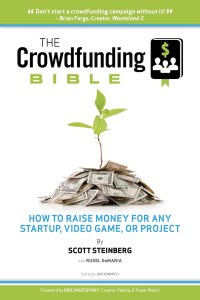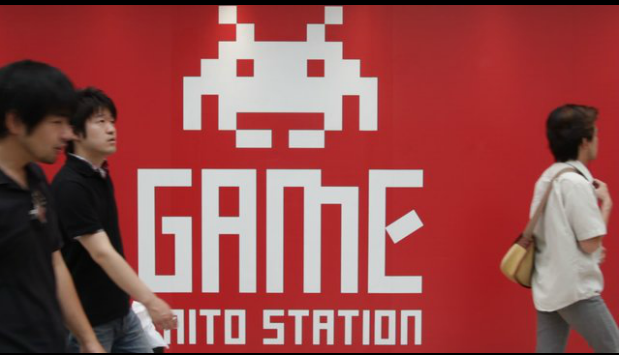The following is an excerpt from Scott Steinberg’s new book, The Crowdfunding Bible. The book is free to download at www.CrowdFundingGuides.com, or in e-book form on Apple, Nook and Sony Reader devices. Check out the previous excerpt: Building a fan base for comic art.
Brad Crawford, Writer/Director
Following in the footsteps blazed by breakout Kickstarter film success Indie Game: The Movie, the idea for Brad Crawford’s motion picture 100 Yen first began to germinate when he visited Japan for a wedding. Armed with a camera, Brad spent the spare time before and after the celebration capturing scenes from Japan’s iconic arcades, which have flourished throughout the nation, despite their boom then meteoric decline in the West. From these initial efforts emerged a trailer and the reel used for Crawford’s IndieGoGo campaign, which gave a documentary film which otherwise might never have seen the light of day a chance at being screened for the general public.
Q. How did things first come together for the project?
A: 100 Yen began with a journey to Japan on my own dime. I was visiting the country for a friend’s wedding and thought it made sense to spend the time productively and capture a piece of its culture. From there, I ended up with a trailer that I thought represented an idea for a film.
For me, having something [visual to show like this] is a key step towards launching a crowdfunding campaign. It also helped that some local filmmakers (namely, Blinkworks of Indie Game: The Movie fame) had just raised $20,000 via Kickstarter, and I was able to wrack their brains for tips and advice.
I had very little concern regarding attempting to use crowdfunding, actually. I approached it as if it was this attractive female that I had always had a crush on and suddenly got the guts to ask out. If she said no, nothing would change. But if she said yes? Just imagine. The benefits of a campaign outweigh any negative aspects that could arise, at least from my perspective. The fact that both campaigns we’ve run have been successful might skew my opinion slightly, however.
The main reason I thought the campaign would work was 1. I had just witnessed Indie Game: The Movie’s massive success with a similar concept and 2. I felt like [fans with an interest in] video games and Japan were two very large demographics that should be fairly easy to locate and advertise to online.
As mentioned, I spoke with the creators of Indie Game: The Movie and studied their campaign, and essentially used their method as a jumping off point for my own campaigns. My target demographic was fairly clear-cut and it helped that I frequent a number of the major sites that are involved with both gaming and Japanese lifestyle. Another key part of the entire campaign was having [notable personalities on our side] like Brian Ashcraft who helped push the film via Kotaku and Ryan Gutierrez who is a well-known figure within the fighting game scene. Both of these figures helped lend credibility to the project and promote it through different media outlets.
As the product I’m creating is a film, I poured all of my energy into creating the best product I could. If I could intrigue viewers with the video, then they would be willing to support my ideas and trust that I could create a product that they would be happy with. That goes double for running a finishing funds campaign: To go back a second time, I really wanted to show how far we had come, and I think our current “official” trailer is leaps and bounds above the original teaser both in terms of content and visuals.
 Q. What should teams consider when putting together offers and rewards?
Q. What should teams consider when putting together offers and rewards?
A: Would you want to purchase what you’re offering? I know that rewards are listed as “perks,” but honestly, I look at them more as items in a store. If $15 gets you a digital copy of the film, I think that is very affordable. That’s why our most recent campaign essentially tops out at $150 contributions: I want people to look at what they can get and be excited about it. I don’t want people to say “I wish I could afford to get the better version.” I don’t want to make this project for rich people only. I want to make an awesome movie that people can be proud to have helped create, so I want it to be accessible to everyone.
I also wanted to supply rewards that people actually want. T-shirts are great, but beyond that I wanted some big-ticket items as well. So we got arcade joysticks that were signed by pro gamers who appear in the film as well as a signed Xbox 360. They say you have to spend money to make money, so don’t get stingy with things like posters and shirts… we found some great printers and created something that we would want to wear or hang in our house.
Q. What one activity or reward seemed to generate the most response from the community? The least? Why?
A: Signed, limited edition items, or things with special features or extras seemed most successful. I was actually very surprised how many people gave us $300 to have their names hidden within the film – I’m sure that wasn’t the only reason to contribute that amount, but I think it made people interested. We haven’t had any negative feedback in terms of perks, but I will say that I was surprised at how many people decided to go with a physical copy of the film vs. the cheaper digital version. I really think it’s all about them wanting to support the project and help us reach our goal. For our campaigns specifically, we’ve caught a lot more of the hardcore market than casual viewers, which I think is a large factor for why the $15 amount isn’t that popular. (Note: After reaching our goal and hitting more mainstream sites like Wired.com and Yahoo.jp, the $15 option got more contributors.)
Q. What PR and social media strategies did you use to get the word out about your campaign? Did you run them yourself, or did you hire a professional?
A: A little from Column A, and a little from Column B. The first run through it was all me plugging away via Facebook and through friends of friends. I would write poorly-worded (in retrospect) emails to websites and blogs in my spare time and just try to get news about the project out.
The second campaign was totally different: We hired a pro and had interviews lined up before day one even hit. We had websites redone and social media goals and targets. We now have physical press kits going out and are trying to line up screening dates so that as soon as the film is complete we can ramp up into full gear and get the news out to the world.
It’s a full-time job to do it right – don’t think that just by putting up a campaign online that it will generate interest and you’ll get funded. You have to hustle and do it well to promote your campaign to the right news and media sites at the right time: Some will want exclusives and some won’t take you seriously and some will keep delaying. Be aggressive in a polite and professional manner or hire a pro. It’s a lot more work than it appears at first glance. Oh… and have a game plan before getting started: Weekly, daily, hourly… the more detailed the better. The more info you can provide and the more you interact with your fans, the better.
The best tool we used when conducting the campaign was Twinitor, a Twitter search engine. It was absolutely essential in my mind: I would have missed 75% of all our users’ activity without it. Also take advantage of tools like Google Analytics and Vimeo Statistics… stats are key, so you know who’s coming to your site, where they’re coming from, and when. Find the source and celebrate it, spread news about it, and get people excited. Don’t rely on Kickstarter or IndieGoGo for marketing either: These services are amazing platforms and they absolutely have been a great help for my film, but they will not spread word about your project alone. Assume they are out to lunch and go out and tell people yourself.
Q. What was it like after the campaign launched?
A: I got tons of emails asking questions and general inquiries about perks and so forth. Answering them is not unmanageable by any means, but make sure to reply to fans promptly, as they are the reason you’re able to succeed at meeting your project goals and creating end results. I try to update Facebook several times a week and point people to our page as the source for the newest info. Updates don’t even have to be fully related to the project – just keep people in the loop. Email or Facebook are my preferred choices for communication. If I need addresses or other fan specifics, I’ll send emails, but if an announcement is general and less important I’ll post it on Facebook. IndieGoGo also has a great update system that you can post to in order to help get important news out.
Timing is everything here too. The first time around, we appeared on some major sites after the campaign had ended and missed some really big opportunities. If I did it all over again, I would have had all of my promotional content prepared well in advance with a day-to-day schedule of updates and plans. I’d also hire a pro that knows your market or knows it better than you as well – it helps a lot.
Q. Your final advice for future campaign creators would be…?
A: Having a rock-solid website in place is critical to help point people in the right direction rather than just the campaign page, which eventually becomes somewhat of a dead link. Also, know your audience, who they are, and where you can find them. Without this knowledge, I don’t know if you’ll be able to accomplish your goals. Do your research, make a list of media sites that might be interested, and find out who to contact there – don’t just use random emails, but rather try to narrow down your targets.
 Professional keynote speaker Scott Steinberg is a leading expert on leveraging new technology trends to enhance business strategy and family life. He is also a noted industry consultant and bestselling author.
Professional keynote speaker Scott Steinberg is a leading expert on leveraging new technology trends to enhance business strategy and family life. He is also a noted industry consultant and bestselling author.
VentureBeat's mission is to be a digital town square for technical decision-makers to gain knowledge about transformative enterprise technology and transact. Learn More

